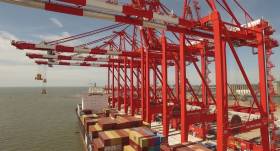Displaying items by tag: Peep Ports
Official Opening of £400m Liverpool2 Container Terminal
#Liverpool2Opens - Liverpool2, one of the world’s most modern shipping terminals, officially opened last Friday at the Port of Liverpool by the Secretary of State for International Trade, Rt Hon Dr Liam Fox MP.
The £400 million investment by Peel Ports, one of the UK’s biggest port operators, will provide a state-of-the-art ocean gateway for UK importers and exporters with road, rail and canal connections linking directly to the heart of the UK mainland, accessing a catchment of over 35 million people, almost 58% of the UK’s population.
The new deep water facility will complement the existing Royal Seaforth Container Terminal at the existing Port of Liverpool, with each terminal having capacity to handle around 1 million containers per annum. The Port is already the country’s biggest transatlantic port (45% market share) and the only major container port in the north or west of the UK.
Liverpool2, which is one of the UK’s largest private sector infrastructure projects, was developed in response to changing trading patterns and shipping industry trends towards the use of ‘mega’ ocean-going container ships. Liverpool2 will now be able to handle the biggest cargo vessels in the world.
Mark Whitworth, CEO of Peel Ports said: “Today marks the beginning of a new era for the Port of Liverpool. Our investment will help global shippers to transport cargo more efficiently to their end destination with lower costs, congestion and carbon emissions. Liverpool is in the right location, providing state-of-the art facilities and technology, and offers a real competitive advantage with a shorter supply chain and providing an all-water route right to the heart of the UK via the Manchester Ship Canal.
“Liverpool 2 will create a new trading gateway in the UK. We are already exploring and succeeding in creating new opportunities for UK exporters, having recently signed a significant Memorandum of Understanding (MOU) to create a strategic alliance aimed at facilitating international trade and generating new business by promoting trade routes between Liverpool and the west coast of South America via the Panama Canal.”
Secretary of State for International Trade Liam Fox said: “Exporting is vital to the economic health of our nation. This investment at Liverpool2 will boost crucial cargo capacity, create local jobs and is yet another sign that the UK is open for business with the world.
“Liverpool is ideally located to increase our trade with countries west of the UK, including the US, Canada and South America, and this new port opens up even more opportunities with new markets and export destinations for UK businesses.”
Liverpool currently has around 8% of the container market in the UK. This figure would be expected to rise to between 15% and 20%.
Gary Hodgson, Chief Operating Officer of Peel Ports, added: “Being able to compete on the scale offered by Liverpool2 is only one aspect of how we’re transforming the port. Our real driving force is a commitment to customers, whether shipping lines or cargo owners, and helping them to achieve their business vision.
“As well as investing in the infrastructure and technology, we’re providing a more integrated service to our customers, whether that’s at the quayside, through port-centric logistics facilities or our wider network of ports.”
The occasion was marked with a major event for nearly 300 customers and stakeholders, featuring pyrotechnics during the opening ceremony and a performance by Alison Moyet.
The new expanded port facility will create an estimated 5,000 jobs direct and indirect jobs, stimulate further growth in the North-west and help to rebalance the UK economy.
Key facts and figures
The terminal construction has seen a site of around 16 hectares reclaimed from the sea. There is a new 854m quay wall and land created from 5.5 million tonnes of sand and silt dredged from the Mersey. The site is large enough to accommodate the stadiums of all four major Liverpool and Manchester football clubs.
The site currently has five ‘megamax’ ship to shore (STS) transfer cranes and 12 quayside container handling cranes (known as CRMGs). Ultimately there will be another three STS cranes and 10 CRMGs. These alone have cost £100m.
The apex of the STS cranes is 92m – four metres short of the height of Westminster’s Elizabeth Tower (Big Ben clock tower). When the boom is raised, it is more than 130m high.
35 million people in the UK & Ireland live closer to Liverpool than the traditional container ports in the South of England.
58% of the UK’s population is closer to Liverpool than its competitor ports in the south.
112km radius around Liverpool has the largest volume and density of large warehousing of any UK region.
More than 28% of the UK’s large warehousing is located in that area.
The North-west has seen a number of significant investments in supply chain warehousing, including warehouses to serve Waitrose, Aldi, Poundland, B&M, Matalan, Missguided and many others.
























































